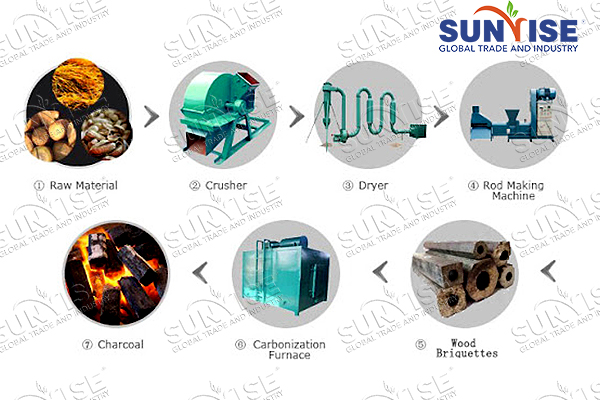Wood charcoal briquettes are a popular fuel source for cooking and heating, offering a convenient and efficient alternative to traditional wood logs and lump charcoal. The production of these briquettes involves several stages, ensuring that they burn consistently and cleanly. Below, we delve into the detailed process of making wood charcoal briquettes, highlighting each critical step and its significance.

Introduction to Wood Charcoal Briquettes
An Efficient Fuel Source
Wood charcoal briquettes are made by compressing charred wood into uniform shapes, providing an efficient and reliable source of heat. They are favored for their long burn time, even heat distribution, and reduced smoke output compared to traditional wood or lump charcoal. The production process not only enhances their combustion properties but also allows for the recycling of wood waste, contributing to environmental sustainability.
The Stages of Wood Charcoal Briquette Production
1. Raw Material Collection and Preparation
The production process begins with the collection of raw materials, primarily wood waste such as sawdust, wood chips, and agricultural residues. These materials are abundant and often sourced from sawmills and woodworking industries. The raw materials are then dried to a low moisture content, typically less than 10%, to ensure efficient carbonization and prevent energy loss during burning.
2. Carbonization
Carbonization is the process of converting the prepared raw materials into charcoal by heating them in the absence of oxygen. This is typically done in a kiln or a retort. The wood waste is subjected to temperatures ranging from 300°C to 500°C, allowing volatile compounds to evaporate and leaving behind a carbon-rich residue. This step is crucial for enhancing the energy content and combustibility of the final briquettes.
3. Crushing and Mixing
Once carbonized, the charcoal is ground into a fine powder using a hammer mill or similar equipment. The powder is then mixed with a binder, which is essential for holding the briquette together. Common binders include starch, clay, or molasses, each contributing to the briquette’s structural integrity without compromising its burning properties.
4. Briquetting
The mixed material is then fed into a briquetting press, where it is compacted into uniform shapes under high pressure. This step is vital for ensuring that the briquettes have a consistent density and size, which facilitates even burning. The pressure and shape of the mold can be adjusted depending on the desired characteristics of the final product.
5. Drying and Packaging
After pressing, the briquettes are dried to remove any residual moisture, further increasing their durability and combustion efficiency. The drying process can be carried out in a controlled environment or naturally under the sun. Once dried, the briquettes are packaged for distribution, ready for use in cooking, heating, or industrial applications.
Advantages and Considerations
Benefits of Briquettes
Wood charcoal briquettes offer numerous advantages, including high energy content, low smoke production, and consistent burn times. They are also easier to handle and store than loose charcoal, making them a convenient fuel choice for households and businesses alike.
Challenges in Production
Despite their benefits, producing charcoal briquettes involves challenges such as ensuring a steady supply of raw materials and optimizing the carbonization process to maximize yield. Additionally, the use of certain binders may influence the emissions and ash content of the briquettes, necessitating careful selection and testing.
Conclusion
The production of wood charcoal briquettes is a multifaceted process that transforms wood waste into a valuable fuel source. Through careful control of each stage, from raw material preparation to final packaging, manufacturers can produce high-quality briquettes that meet the needs of diverse consumers. As demand for sustainable energy solutions grows, wood charcoal briquettes continue to play a crucial role in providing efficient and eco-friendly alternatives to traditional fuel sources. Visiting: https://www.char-molder.com/product/wood-charcoal-briquette-making-machine/
Leave a Reply